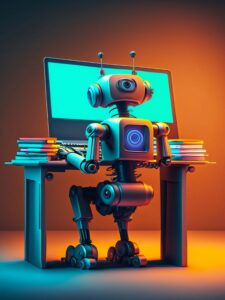7 Essential Tools Required for Artificial Intelligence Development
In the rapidly evolving landscape of technology, the tools required for artificial intelligence have become indispensable for developers, researchers, and businesses alike.
As AI continues to reshape industries and revolutionize problem-solving approaches, understanding and mastering these tools is crucial for staying competitive and innovative.
This comprehensive guide will explore the seven essential tools required for artificial intelligence development, providing insights into their functionalities, applications, and significance in the AI ecosystem.
By delving into these powerful instruments, we’ll equip you with the knowledge needed to embark on your AI journey or enhance your existing skills.
From data preparation to model deployment, these tools form the backbone of AI development, enabling creators to bring their visionary ideas to life.
Whether you’re a seasoned professional or a curious beginner, understanding the tools required for artificial intelligence is the first step towards harnessing the full potential of this transformative technology.
Let’s dive into the world of AI development and discover the key tools that are shaping the future of intelligent systems.
We strongly recommend that you check out our guide on how to take advantage of AI in today’s passive income economy.
Table of Contents
1. Python: The Foundation of AI Development
Why Python Reigns Supreme in AI
When it comes to the tools required for artificial intelligence, Python stands out as the cornerstone of AI development.
Its simplicity, versatility, and extensive library ecosystem make it the go-to language for AI practitioners worldwide.
Python’s readable syntax and gentle learning curve allow developers to focus on solving complex AI problems rather than grappling with intricate code structures.
The language’s popularity in the scientific computing community has led to the creation of numerous AI-specific libraries and frameworks, further solidifying its position as an essential tool for AI development.
Python’s ability to handle data manipulation, statistical analysis, and machine learning algorithms with ease makes it an indispensable asset in any AI developer’s toolkit.
From prototyping to production, Python’s flexibility enables seamless transitions between different stages of AI project development.
Key Python Libraries for AI
Within the Python ecosystem, several libraries have emerged as crucial tools required for artificial intelligence projects.
NumPy, with its powerful array operations and mathematical functions, forms the foundation for numerical computing in AI.
Pandas provides data manipulation and analysis capabilities, essential for preparing and exploring datasets used in AI models.
Scikit-learn offers a wide range of machine learning algorithms and tools for data preprocessing, model selection, and evaluation.
TensorFlow and PyTorch, two of the most popular deep learning frameworks, provide the building blocks for creating and training complex neural networks.
These libraries, along with many others, create a rich ecosystem that empowers developers to tackle diverse AI challenges efficiently.
By leveraging these Python libraries, AI practitioners can accelerate their development process and focus on innovation rather than reinventing the wheel.
2. Integrated Development Environments (IDEs): Streamlining AI Workflows
The Power of Specialized AI IDEs
Among the essential tools required for artificial intelligence development, Integrated Development Environments (IDEs) play a crucial role in enhancing productivity and streamlining workflows.
AI-focused IDEs provide a comprehensive suite of features tailored to the unique needs of AI developers, combining code editing, debugging, and project management capabilities.
These environments often come equipped with AI-specific plugins and integrations, allowing seamless access to popular libraries and frameworks.
By offering intelligent code completion, real-time error detection, and interactive data visualization, AI IDEs significantly reduce development time and improve code quality.
Some popular IDEs for AI development include PyCharm, Jupyter Notebook, and Visual Studio Code with AI extensions.
These tools not only facilitate efficient coding but also provide collaborative features that enable team-based AI projects.
Jupyter Notebooks: Interactive AI Development
Jupyter Notebooks deserve special mention among the tools required for artificial intelligence due to their unique approach to interactive computing.
This web-based IDE allows developers to create and share documents containing live code, equations, visualizations, and narrative text.
Jupyter Notebooks excel in exploratory data analysis, model prototyping, and result visualization, making them invaluable for AI research and development.
The ability to execute code cells individually and see immediate results promotes an iterative development process, crucial for fine-tuning AI models.
With support for multiple programming languages and easy integration with data science libraries, Jupyter Notebooks have become a staple in AI education and professional development.
Their collaborative nature also facilitates knowledge sharing and reproducibility in AI projects, enhancing team productivity and fostering innovation.
3. Version Control Systems: Ensuring Collaboration and Code Integrity
Git: The Backbone of AI Project Management
In the realm of tools required for artificial intelligence, version control systems, particularly Git, are indispensable for managing complex AI projects.
Git enables developers to track changes, collaborate effectively, and maintain multiple versions of their codebase with ease.
For AI projects that often involve iterative development and experimentation, Git’s branching and merging capabilities prove invaluable.
Developers can create separate branches for different model architectures or feature implementations, allowing for parallel experimentation without affecting the main codebase.
Git’s distributed nature also facilitates collaboration among team members, enabling seamless integration of contributions from multiple developers.
This is particularly crucial in AI research and development, where projects often involve interdisciplinary teams working on various aspects of a complex system.
GitHub and GitLab: Platforms for AI Collaboration
While Git provides the underlying version control system, platforms like GitHub and GitLab have emerged as essential tools required for artificial intelligence collaboration and project hosting.
These platforms extend Git’s functionality by offering features such as issue tracking, project management boards, and code review processes.
For AI projects, these platforms serve as centralized repositories where teams can store not only code but also datasets, model weights, and documentation.
The ability to create public repositories also fosters open-source AI development, allowing developers to share their work with the global AI community.
Features like continuous integration and deployment (CI/CD) pipelines are particularly useful for AI projects, enabling automated testing and deployment of models.
By leveraging these platforms, AI teams can streamline their development processes, improve code quality, and accelerate innovation through community collaboration.
4. Data Preprocessing and Feature Engineering Tools
Pandas: The Swiss Army Knife of Data Manipulation
Among the critical tools required for artificial intelligence, data preprocessing and feature engineering tools stand out for their role in preparing high-quality datasets.
Pandas, a powerful Python library, excels in this domain by providing a wide array of functions for data manipulation and analysis.
With Pandas, AI developers can efficiently handle structured data, perform complex operations, and prepare datasets for model training.
Its DataFrame structure offers an intuitive way to work with tabular data, supporting operations like filtering, grouping, and merging with ease.
Pandas also provides robust tools for handling missing data, a common challenge in real-world AI projects.
By leveraging Pandas, developers can streamline their data preprocessing workflows, ensuring that their AI models are trained on clean, well-structured data.
Feature Engineering Libraries: Enhancing Model Performance
Feature engineering, the process of creating new features from existing data, is a crucial step in developing effective AI models.
Several specialized libraries have emerged as essential tools required for artificial intelligence feature engineering tasks.
Featuretools, for instance, automates the process of feature engineering by generating relevant features from relational datasets.
Tsfresh focuses on extracting meaningful features from time series data, a common requirement in many AI applications.
Category encoders provide various methods for handling categorical variables, an essential step in preparing data for many machine learning algorithms.
By utilizing these feature engineering tools, AI developers can significantly enhance the performance of their models by creating rich, informative feature sets.
5. Machine Learning Frameworks: Powering AI Model Development
TensorFlow: Google’s Powerhouse for Deep Learning
When discussing the tools required for artificial intelligence, machine learning frameworks take center stage, with TensorFlow being a prominent player in this field.
Developed by Google, TensorFlow offers a comprehensive ecosystem for building and deploying machine learning models, particularly excelling in deep learning applications.
Its flexible architecture allows developers to create complex neural networks and train them efficiently on various hardware platforms, including GPUs and TPUs.
TensorFlow’s ability to handle large-scale distributed training makes it suitable for tackling big data problems in AI.
The framework’s high-level APIs, such as Keras, provide an intuitive interface for rapid prototyping and experimentation.
Additionally, TensorFlow’s ecosystem includes tools for model serving, mobile deployment, and visualization, making it a versatile choice for end-to-end AI development.
PyTorch: Dynamic Computation Graphs for Research
PyTorch has rapidly gained popularity as one of the essential tools required for artificial intelligence, particularly in research-oriented environments.
Developed by Facebook’s AI Research lab, PyTorch offers a dynamic computational graph that allows for more flexible and intuitive model development.
Its Python-first approach and clean API make it easier for researchers to experiment with novel architectures and algorithms.
PyTorch’s strong support for GPU acceleration ensures efficient training of complex models, while its extensive library of pre-built modules facilitates rapid prototyping.
The framework’s seamless integration with the Python scientific computing ecosystem makes it a favorite among academics and industry researchers alike.
With features like distributed training and mobile deployment, PyTorch has evolved into a comprehensive solution for AI development across various domains.
6. Model Evaluation and Visualization Tools
Scikit-learn: Comprehensive ML Evaluation Suite
In the arsenal of tools required for artificial intelligence, model evaluation and visualization tools play a crucial role in assessing and interpreting AI models.
Scikit-learn, while primarily known for its machine learning algorithms, offers an extensive set of tools for model evaluation and selection.
Its metrics module provides a wide range of evaluation metrics for classification, regression, and clustering tasks, enabling developers to assess model performance comprehensively.
Scikit-learn’s model selection module offers tools for cross-validation, parameter tuning, and feature selection, essential for optimizing AI models.
The library also includes utilities for generating learning curves and validation curves, helping developers understand model behavior and identify overfitting or underfitting issues.
By leveraging Scikit-learn’s evaluation tools, AI practitioners can make informed decisions about model selection and refinement, leading to more robust and reliable AI systems.
Matplotlib and Seaborn: Visualizing AI Insights
Visualization is a critical aspect of AI development, and tools like Matplotlib and Seaborn have become indispensable in the toolkit of AI practitioners.
These libraries offer a wide range of plotting functions that allow developers to create insightful visualizations of data, model performance, and results.
Matplotlib provides a MATLAB-like interface for creating static, animated, and interactive visualizations in Python.
Its flexibility allows for the creation of customized plots tailored to specific AI visualization needs.
Seaborn, built on top of Matplotlib, offers a higher-level interface for creating statistical graphics.
It excels in creating complex visualizations like heatmaps, violin plots, and pair plots, which are particularly useful for exploring high-dimensional data in AI projects.
By utilizing these visualization tools, AI developers can gain deeper insights into their data and models, facilitating better decision-making throughout the development process.
7. Deployment and Monitoring Tools: Bringing AI to Production
Docker: Containerizing AI Applications
As we round out our exploration of tools required for artificial intelligence, we must consider the crucial aspect of deployment and monitoring.
Docker stands out as an essential tool for containerizing AI applications, ensuring consistency across different environments.
By encapsulating AI models and their dependencies in containers, Docker simplifies the deployment process and minimizes environment-related issues.
This containerization approach allows for easy scaling of AI services, crucial for handling varying workloads in production environments.
Docker’s ecosystem also includes tools for orchestrating multiple containers, enabling the deployment of complex AI systems with interconnected components.
For AI teams, Docker streamlines the transition from development to production, ensuring that models behave consistently across different stages of deployment.
MLflow: Managing the ML Lifecycle
MLflow has emerged as one of the vital tools required for artificial intelligence, specifically for managing the entire machine learning lifecycle.
This open-source platform provides a centralized way to track experiments, package code into reproducible runs, and share and deploy models.
MLflow’s experiment tracking feature allows teams to log and compare parameters, metrics, and artifacts across multiple runs, facilitating model comparison and selection.
Its model registry component enables version control for deployed models, crucial for maintaining and updating AI systems in production.
MLflow’s flexibility in integrating with various ML frameworks and deployment platforms makes it a versatile choice for diverse AI projects.
By adopting MLflow, AI teams can improve collaboration, reproducibility, and the overall management of their machine learning projects from conception to deployment.
Conclusion
As we’ve explored throughout this article, the tools required for artificial intelligence development form a comprehensive ecosystem that empowers innovators to push the boundaries of what’s possible.
From Python’s versatility to specialized frameworks like TensorFlow and PyTorch, these tools provide the foundation for creating sophisticated AI systems.
The importance of robust development environments, version control systems, and data preprocessing tools cannot be overstated in streamlining the AI development workflow.
Equally crucial are the evaluation, visualization, and deployment tools that ensure AI models not only perform well in controlled environments but also deliver value in real-world applications.
As the field of AI continues to evolve, staying updated with these tools and their capabilities is essential for developers and organizations alike.
The tools required for artificial intelligence are not just technical assets; they are enablers of innovation, driving the advancement of AI across industries.
By mastering these tools, developers can unlock new possibilities, solve complex problems, and contribute to the exciting future of artificial intelligence.
Frequently Asked Questions (FAQ)
What tool is used in AI?
Multiple tools are used in AI development, including:
- Programming languages like Python and R
- Machine learning frameworks such as TensorFlow and PyTorch
- Integrated Development Environments (IDEs) like PyCharm and Jupyter Notebooks
- Data preprocessing libraries such as Pandas and NumPy
- Version control systems like Git
- Model evaluation and visualization tools like Scikit-learn and Matplotlib
- Deployment and monitoring tools such as Docker and MLflow
These tools collectively form the ecosystem required for developing, training, and deploying AI models.
What is the most popular AI tool?
While popularity can vary depending on specific use cases and communities, some of the most widely used AI tools include:
- Python: As the primary programming language for AI development
- TensorFlow: A popular open-source machine learning framework
- PyTorch: Another widely-used deep learning framework, especially in research
- Scikit-learn: A machine learning library for classical ML algorithms
- Jupyter Notebooks: An interactive development environment popular in data science and AI
- GitHub: For version control and collaboration in AI projects
It’s worth noting that the field of AI is rapidly evolving, and tool popularity can shift over time as new technologies emerge.
How many tools are in AI?
There isn’t a fixed number of tools in AI as the field is constantly evolving, with new tools being developed regularly. However, AI encompasses a wide range of tools, including:
- Programming languages
- Machine learning libraries and frameworks
- Data preprocessing and analysis tools
- Model training and optimization tools
- Visualization libraries
- Deployment and production tools
- Cloud platforms for AI
- Specialized tools for natural language processing, computer vision, and other AI subfields
The number of tools can easily reach into the hundreds when considering all the libraries, frameworks, and platforms available for various aspects of AI development.
Which AI tool is better than ChatGPT?
It’s important to note that comparing AI tools directly, especially to ChatGPT, can be challenging as they often serve different purposes. ChatGPT is a large language model designed for natural language processing tasks. Other AI tools may excel in different areas:
- For image generation: Tools like DALL-E 2 or Midjourney might be considered “better” in their specific domain.
- For speech recognition: Tools like Google’s Speech-to-Text API or Mozilla’s DeepSpeech might be more suitable.
- For specialized language tasks: Models like BERT or GPT-3 might outperform in certain scenarios.
The concept of “better” depends on the specific task, context, and requirements. Each tool has its strengths, and the best choice depends on the particular application and needs of the project. It’s also worth noting that AI technology is rapidly advancing, and new tools that surpass current capabilities are continually being developed.

We strongly recommend that you check out our guide on how to take advantage of AI in today’s passive income economy.




